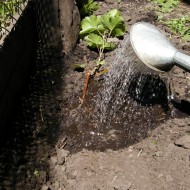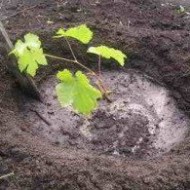Features of planting and growing super-early grapes of the Super Extra variety
Content
Breeding history of the variety
Super Extra was bred in Novocherkassk as a result of the selection of two varieties – Cardinal and Talisman. Amateur winegrower Evgeny Pavlovsky crossed the pollen of these species.
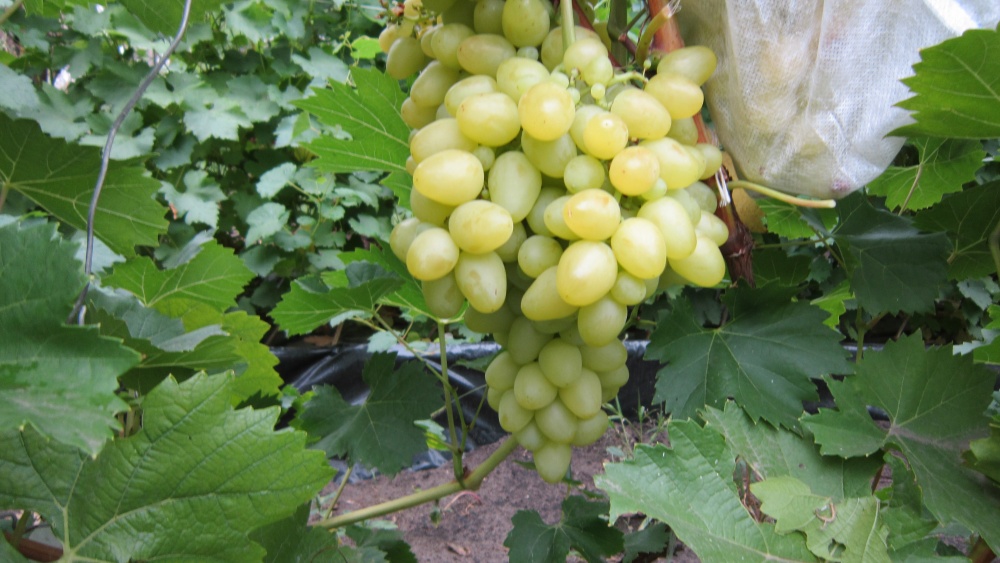
The Cardinal has a nutmeg flavor and large bunches, and the Talisman – high resistance to low temperatures. Thus, the hybrid combined these properties and became one of the best early maturing table varieties.
Botanical portrait of culture
Super Extra grapes are tall bushes with light berries. A ripe bunch glows in the sun, which enhances the presentation of the berries.
Description of the bush and vine
After planting, the bushes grow very quickly and reach a height of 1.5–3 m. Young shoots are light green. In the process of aging, they become woody and acquire a brown tint. The leaves are large, of the same shape, bright green.
Description of bunches and berries
The bunches of this variety are very large, their average weight is 700–900 g. With good care, record holders can reach a mass of 1.5–1.7 kg. The shape of the bunch is triangular, branched, loose.
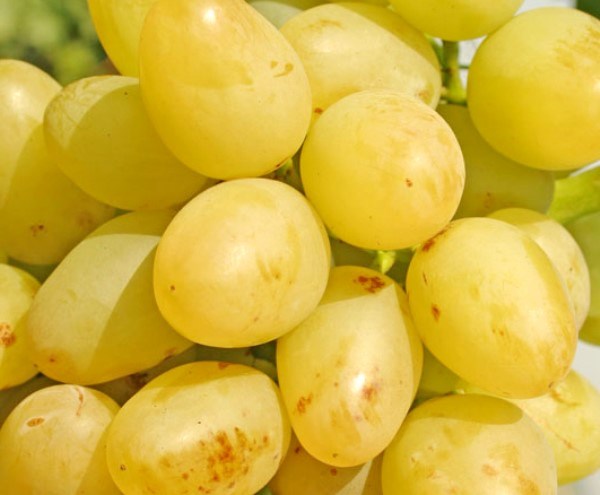
The berries are large, weighing from 10 to 12 g. The shape is oval, slightly pointed at the bottom. Color - from light yellow at the beginning of ripening to amber at the end. The skin is firm but edible. The pulp of a ripe berry is fleshy, juicy, very sweet. Grape growers recommend those who prefer a sweet and sour taste to pick the bunches a week before fully ripening, when they contain a small amount of acid.
Video «Features of Super Extra grapes»
From this video you will learn about the intricacies of growing a hybrid.
Main characteristics
The early table variety Super Extra, due to its high productivity, is used in winemaking and juice production.
Pollination, ripening and fruiting dates
This grape variety belongs to the category of very early grapes.
The ripening period is from 85 to 100 days. In the south, it begins to ripen in the first decade of July, in the northernmost regions - in early August.
Abundant fruiting begins 10-14 days after the onset of ripening. It lasts about two weeks. After the first harvest, stepchildren's clusters are formed. They are much smaller, but sweeter and better pollinated.
Productivity and use of fruits
The yield of the variety is very high. With proper care, you can harvest 10 to 14 kg from one bush. You can squeeze juice from berries, which will be stored for a long time thanks to protective substances. If it comes out too sweet, you can dilute it with sour apple juice. This will balance the taste of the finished product and give new facets of taste.

Thanks to the pronounced nutmeg flavor, a fine white wine is obtained from the grapes. It can be made entirely from Super Extra or mixed with other varieties. The most interesting combinations are obtained by adding a small amount of dark grapes. This will make the taste of the wine more complex and interesting and will give it a pleasant pinkish color.
Drought and frost resistance
This variety can withstand cold up to –25 ° C. In summer, it can give a high yield at low temperatures of + 12 ... + 15 ° C. This allows it to be grown in northern regions with short summers and extremely cold winters, where even unpretentious grape varieties rarely take root.
In the south, where winter temperatures rarely drop below 0 ° C, growers do without abundant shrub cover. In summer, he ripens in early July and even manages to give a second crop. Moreover, it is resistant to drought, which is common in the southern regions.
Advantages and disadvantages of the variety
- frost resistance up to –25 ° C;
- high yield - up to 14 kg per bush;
- early ripening;
- large size of berries and bunches;
- pleasant taste and versatility of use;
- low susceptibility to diseases and pests;
- dense skin for easy transportation.
- intolerance to overloading the bush and the need to constantly remove ripe bunches;
- different sizes of berries;
- increased attractiveness of the variety for wasps;
- weak resistance against phylloxera aphids.
Characteristic features of cultivation
The hybrid does not require special growing conditions. To grow healthy shrubs, planting and pruning times must be properly timed and fertilized.
Landing algorithm
The grapes are planted in spring or fall. Spring planting is best practiced in the north, so that young immature seedlings do not have to endure the frosty winter. In the south, they can be planted in October-November.
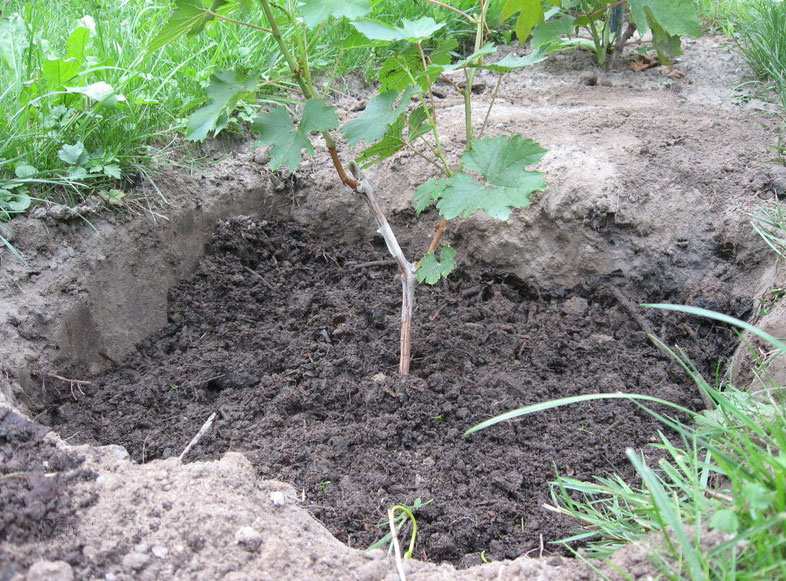
Before planting, the seedling must be placed in water for 36–48 hours. At this time, it is necessary to prepare the correct pit. Its dimensions should be 80x80x80 cm.A 10-centimeter layer of fertile soil rich in nutrients must be poured onto its bottom, 8–10 kg of manure, nitroammofosk and ash. The soil is again poured from above. This supply of fertilizers will be enough for the bush for several years.
The seedling is planted at a height of 35–40 cm from the surface of the earth. He is covered with earth dug out of the hole. A hole with a depth of 10 is left on the surface–15 cm for watering. Immediately after planting, the bush is watered abundantly 3–4 buckets of water.
Watering and feeding
Immediately after planting, the grapes are watered at least once a week. When the plant takes root, it can be irrigated no more than 2–3 times a month. Pour 20 under each bush–30 liters of water. Moistening is carried out gradually so that the liquid has time to be absorbed. In August, watering is stopped to form the vine.
In the spring, the bushes are fertilized with manure, bird droppings, compost, nitroammophos. In the fall, you can apply mineral fertilizers: nitrogen, phosphorus, potassium.
Pruning vines and shaping a bush
Experienced gardeners advise pruning in the fall when the juices slow down. It also makes it easier to cover the bushes for the winter.

A few weeks after the end of fruiting, you can start forming a bush. The thicker the shoot, the more eyes should be left on it. Since the bunches of this variety are voluminous, their number corresponds to the size of the vine in diameter. For example, 5 eyes are left on a 5 mm thick shoot, on a 12 mm branch – 12. Having calculated the required number of buds, it is necessary to cut off the vine at the level of living wood with a sharp pruner.The cut must be light green.
After pruning, the grapes are watered abundantly and left alone for 1–2 weeks. After that, it can be covered for the winter.
Breeding features
The easiest way to reproduce – dusting the shoot with earth. To do this, in the spring or early summer, a strong healthy vine is chosen and at a distance of 30–40 cm from the bush dig a small depression in the ground.
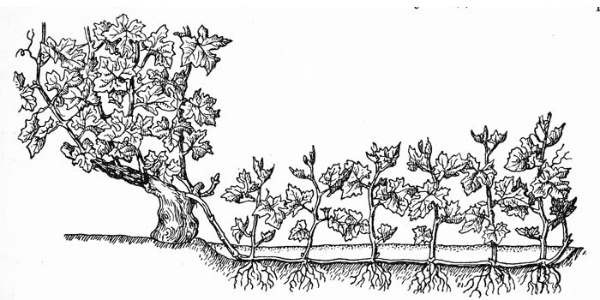
The branch is gently tilted to the ground and sprinkled with soil. In the fall, when new bushes are formed, they are separated from each other, and in the spring of next year they are planted as full-fledged seedlings.
Diseases and pests
The Super Extra hybrid variety is highly resistant to diseases and parasites. The weakest point of this plant is the phylloxera aphid. When affected by this pest, yellowish blistery bulges appear on the leaves. Insects spread by wind, clothing and garden tools. The infected plant begins to turn yellow, withers, and bears little fruit.
You can fight phylloxerra only by mechanical removal of the affected parts. They are isolated from healthy plants and must be burned. If you do not notice the appearance of aphids in time, it may be necessary to completely destroy the bush in order to save the entire vineyard.
Winegrowers reviews
Amateur gardeners and experienced growers leave high reviews for the hybrid variety.
Super Extra – prolific and resistant to diseases, pests and frost. With proper care, it gives at least 10 kg per bush. Due to its expressive taste, it is widely used in winemaking.

